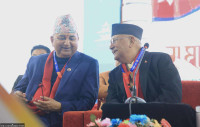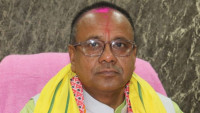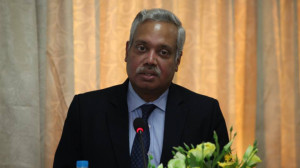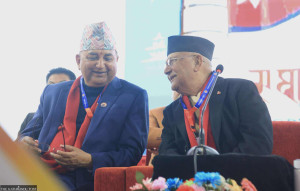National
Himalaya Shumsher, first governor who formalised Nepal’s economy, dies at 95
Rana is credited with developing country’s banking system.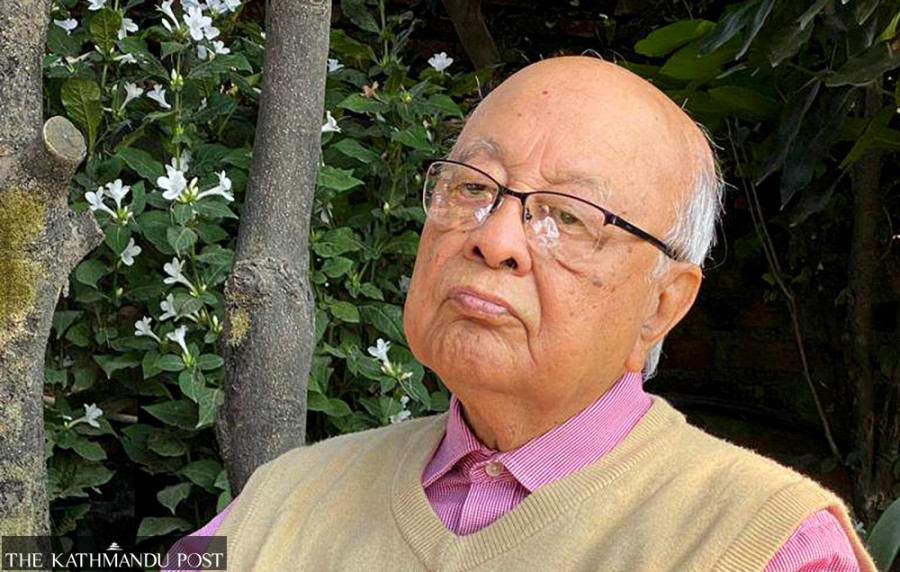
Prithvi Man Shrestha
Himalaya Shumsher Rana, the first governor of the Nepal Rastra Bank who is credited for bringing Nepali currency in wider circulation within the country, passed away on Sunday morning. He was 95.
In a statement on Sunday, the Norvic Hospital, where Rana had been hospitalised, confirmed his death. He had been receiving treatment for Parkinson's disease for the past five years, according to the hospital.
Condolences are pouring in from different walks of life, remembering Rana's contribution to the Nepali economy, evolution of Nepal’s banking sector, contribution to the private sector businesses and his contribution as a civil society leader.
The incumbent Nepal Rastra Bank (NRB) Governor Maha Prasad Adhikari remembered Rana as a prominent economist, economic thinker and promoter of Nepal’s financial sector.
“As the governor of the central bank, he established the base for monetary and banking infrastructure in Nepal by bringing the Nepali currency into circulation, determining the exchange rate for the Nepali currency with the Indian currency for the sustainable development of Nepal’s banking system,” Adhikari said in his condolence message.
“Nepal Rastra Bank has lost a guardian and the nation has lost a skilled economist and the financial sector has lost his guidance from his demise.”
Rana had served as Nepal’s first central bank governor from April 26, 1956 to February 7, 1961.
He was born on January 8, 1928 in the dynastic Rana family and studied at Durbar High School. He post-graduated from the Bombay University, India and returned home to join government service.
Before being appointed as the first governor of the central bank, he had served as finance secretary under the leadership of the then Finance Minister Subarna Shumsher Rana right after the country had a democratic transition by ending a 104-year-long Rana rule in early 1950s.
He is credited with helping to modernise the customs administration, strengthening inland revenue administration and establishing the office of auditor general for financial transparency in public spending during his tenure as finance secretary.
Until that time, the country didn’t have its own central bank, although the Nepal Bank Limited, Nepal’s first commercial bank, had already been established.
Prior to the establishment of the central bank, he was entrusted with the task of drafting its charter as an officer-on-special-duty. For this, Rana had worked in coordination with Sardar Hansa Man Singh, the principal royal advisor, according to the central bank.
In its Golden Jubilee Publication, “Nepal Rastra Bank in Fifty Years", the central bank highlighted the key tasks Rana carried out as its first governor.
“Rana immediately started his campaign to address the problems faced by the Nepalese economy,” the publication stated. “The foremost challenge at that time was to increase the circulation of Nepali currency all over the Kingdom (Nepal). In this context, the Act to Increase Nepalese Currency Circulation, 1957, declaring the Nepalese currency as the only legal tender of the country, was promulgated on July 12, 1957.”
In order to supplement the Act, the NRB, for the first time, issued its own currency notes from February 19, 1959 (Democracy Day). In this connection, four denominations—Re1, Rs5, Rs10 and Rs100—were issued.
The government, at the request of the central bank, gradually decreased the production of coins. The gradual replacement of metallic money by paper money greatly facilitated monetary transactions.
Another anomaly, at that time in the Nepali economy, was the prevalence of wide circulation of Indian currency and the uncertainty of its exchange rate with the Nepali currency. The absence of any regulatory authority for official intervention in the exchange rate fixed by local money changers led to speculative activities. “To address this issue, the exchange rate was fixed at Rs160 for Indian Rs100 on 13 April 1960. Secondly, the Foreign Exchange Control Act, 1960 was promulgated on May 23, 1960 which established the NRB as the sole custodian of foreign exchange in the Kingdom of Nepal,” the publication stated.
Stabilisation of the exchange rate between the Nepali and the Indian currency and the enactment of the two Acts during the tenure of Governor Rana proved to be a milestone in enhancing the public confidence in the national currency and eliminating the dual currency period, according to the NRB.
These steps significantly increased the monetization of the economy in successive years, the central bank said.
With a view to smoothen and facilitate foreign exchange transactions, foreign currency accounts were maintained with the central banks of India and England as well as the commercial banks of the United States and Japan during Rana’s tenure as governor.
Previously, foreign funds would be channelised through the Reserve Bank of India only, according to the central bank. Rana's contribution in both monetizing the economy and developing the organisational structure of the Bank during the very crucial and difficult times, is really commendable,” the NRB said.
Former Finance and Foreign Minister and Former Central Bank Governor Bhekh Bahadur Thapa remembered Rana as a figure who contributed to modernising Nepal’s economy.
“He introduced modern banknotes in the country and helped modernise the Nepali economy,” said Thapa, who served as the central bank governor from August 1966 to July 1967.
After retiring from the central bank, Rana had been affiliated to the United Nations, serving in various capacities in different countries. After Nepal's economy liberalised, Rana established Himalayan Bank in 1993 in a joint venture with Habib Bank Limited of Pakistan. The bank emerged as one of the leading private sector banks in the country.
Rana also established the Gorkha Brewery Company, bringing international beer brands like Tuborg and Carlsberg to Nepal.
Besides the economic sector, he was also active in promoting peace and democracy in the country. When the country was facing the decade-long conflict, Rana was making efforts to bring the then Maoist rebels into peaceful politics.
“During the insurgency period, I remember him issuing several statements as a leader of civil society for a peaceful resolution of the conflict,” said Khim Lal Devkota, politburo member of the CPN (Maoist Centre), the party that led the insurgency.
“After the peace process began, I met him several times and he used to insist on leading the peace process to a logical conclusion.”
Rana was also involved in monitoring elections over the last several years as the chairperson of the General Election Observation Committee.
“I remember him as a pioneering figure of Nepal’s central bank, an economist and a social worker,” said Thapa, the former governor of the apex bank.




 10.12°C Kathmandu
10.12°C Kathmandu




